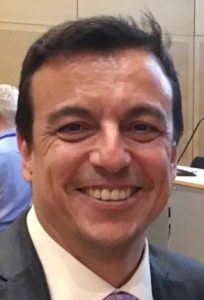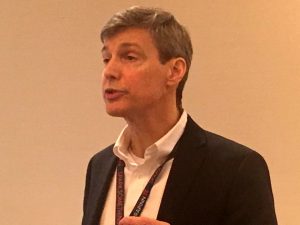#ECRD2018 – Duchenne Needs ‘Thinking Outside the Box’ to Advance Treatments But Investors Taking Note, Advocate Says

Euro banknotes. (Photo by Larry Luxner)
The Greek father of a boy with Duchenne muscular dystrophy (DMD) — and a financial consultant — says that when it comes to research on rare diseases, crowdfunding and support from the European Union are nice, but simply not enough.
Venture capital and large-scale corporate investment are clearly the way to go, said Dimitrios Athanasiou, a board member of the World Duchenne Organization — which is based in the Netherlands — and head of the Parent Project Muscular Dystrophy Association of Greece. His 7-year-old son, Hermes, was diagnosed with DMD shortly after his first birthday.
“As soon as I got the diagnosis, I reached out to my broker friends” for advice on which companies to follow, said Athanasiou, speaking at the recent 9th European Conference on Rare Diseases & Orphan Products in Vienna.
Athanasiou, who lives in Athens, is a member of Eurordis, which sponsored the conference, as well as a patient expert with the European Medicines Agency, the EU’s regulatory arm. The average cost to develop and win EU approval to market a new therapy today is $2.6 billion, including drug failures and exploratory expenses, according to his conference presentation.
About 8 percent of the world’s population is estimated to have a rare disease. This translates to a market of 30 million people in the 28 EU member countries and 350 million globally.
“Rare diseases affect more people than all cancers and HIV combined,” Athanasiou said. As a consequence, he predicted that the world orphan drug market will almost double between 2016 and 2022 — peaking at $209 billion in 2022, with an average 11 percent growth per year.
Rare diseases ‘becoming more sexy’
Indeed, the average yearly per-patient cost of an orphan drug in 2016 was $140,443, versus $27,756 for those not treating rare diseases.
In six countries alone — the U.S., France, Germany, Italy, Spain and the U.K. — the market for Duchenne therapies will reach a combined $1 billion in 2019, Athanasiou said. That’s up from $8.2 million in 2014, representing a compound annual growth rate of 160.5 percent.
Meanwhile, Duchenne be devastating economically to families throughout North America and Europe.
“The economic impact of DMD, although it is a rare disease, is quite remarkable,” Athanasiou said, estimating its cost to society in 2012 — in terms of hospital stays, caregivers’ work absences and lost productivity — at $154 million in Italy, $200 million in the U.K., $278 million in Germany, and $1.21 billion in the United States.
“Rare diseases are becoming more sexy,” Athanasiou said, noting that Series A financing — which refers to the first round of financing given to a new business once seed capital has been provided — for companies working in this field nearly doubled from 2014 to 2015, with more than 10 percent of Series A funds in 2015 going to rare disease startups.
“The pharma industry is shying away from sponsorship of early clinical research, and biomedical innovation has become riskier, more expensive and more difficult to finance with traditional sources such as private and public equity,” he said. “We have to be aware of what they’re facing so we know what our own role is.”
Given the expiration of patents and the rising costs of clinical trials, pharmaceutical companies generally focus on treatment candidates that have passed early regulatory hurdles.
The average success rate for a new therapy in rare diseases is 76 percent from Phase 1 to Phase 2, and 50 percent from Phase 2 to Phase 3, he said. Those figures compare to an average success rate for a new therapy in chronic high-prevalence diseases of 58 percent from Phase 1 to Phase 2, and 27 percent from Phase 2 to Phase 3, , his presentation shows.
From Phase 1 through to approval, the difference is even more remarkable: 25.3 percent for rare disease therapies, and only 8.7 percent for chronic high-prevalence therapies.
“Clearly,” he said, “investing in a rare disease drug in the early phases, the difference can even be double than for any other drug.”
Exonics CEO banks on SingleCut CRISPR
A prime example of a venture-capital startup is Exonics Therapeutics, which took off in February 2017 with $5 million in seed money from Cure Duchenne Ventures — the investment arm of the nonprofit group CureDuchenne. Nine months later, Exonics received a $40 million injection of funds from The Column Group, a San Francisco venture capital firm.
Exonics uses SingleCut CRISPER/Cas9 technology licensed exclusively from the University of Texas Southwestern Medical Center in Dallas, based on research led by Eric Olson.
Olson, a molecular biologist, is founder and chief science adviser of Exonics; the company’s CEO is John Ripple, a veteran biotech and pharmaceutical industry consultant.
“My founder is a very pragmatic guy in the way he developed his technology,” Ripple said of Olson and SingleCut during a talk at the 2018 World Orphan Drug Congress in Maryland. “This is probably the least scientifically interesting approach you’ll hear about in CRISPR. He makes one cut, and we deliver with viral vectors. The goal is to infect every cell in the body, then have your promoter only express CRISPR/Cas9 in the muscle cells.”
A promoter is a region of DNA that triggers the process in which gene information is read and a protein generated. The technology is still in the pre-clinical stage, however.
“We started with a bold vision: our goal is to halt progression of the disease,” Ripple said. “Some Duchenne patients are living beyond 30 years of age — just not enough of them.”
Duchenne, which generally strikes boys between the ages of 3 and 5, affects about 1 in 5,000 male births; about 300,000 boys and young men have DMD worldwide.
Not everyone will benefit
The dystrophin gene — the largest known human gene — has more than 3,000 mutations. About 60 to 70 percent of them are exon deletions, 25 to 35 percent point mutations, and 5 percent duplications.
The dystrophin protein itself contains 79 exons; in its mouse experiments, Exonics tends to focus on the “hotspot” from 43 to 55, which covers about 43 percent of all DMD patients. Mutations of exon 51 alone are responsible for 13 percent of cases.
Asked about off-target or undesirable effects, Ripple conceded they’re always a concern.
“You’d have to get two simultaneous cuts, which happens less than 1 percent of the time, and that’s when you run into problems,” he said. “But to date, we have not seen any off-target effects.”
Ripple, emphasizing the importance of early diagnosis in Duchenne, said that as a starting point, Exonics plans to ramp up to eight DMD mouse models that might lead to a way of treating half of all Duchenne patients — and possibly as many as 80 percent.
However, he doesn’t expect SingleCut to benefit everyone with Duchenne.
“There’s really great work going on here,” he said, but there are limits and a need “to draw the line … I’m hoping that with a combination of gene editing and gene therapy, we’ll be able to treat most patients.”








